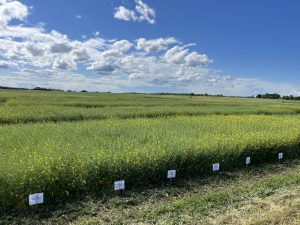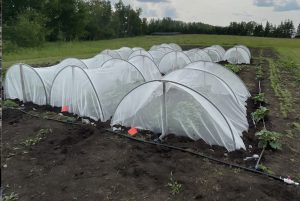Background Information
The Saskatchewan Conservation Learning Centre Inc. (CLC) is a producer-driven, non-profit corporation with formal status as a registered charity. The CLC was established in 1993 under the Parkland Agricultural Research Initiative, a component of the Green Plan. The CLC demonstrates soil and water conservation technology on a farm scale. It also serves as a field laboratory for evaluation and applicability of new research and technology.
The CLC is unique as a research and demonstration facility because it features rolling topography, wetlands, and remnant native upland areas rather than most research facilities’ very uniform landscapes. Because of the variable topography and emphasis on field-scale activities, many scientists from federal, provincial, university, and private research institutions undertake work at the Centre. The CLC also has continued strong support from multiple agencies and corporations that participate in demonstration and research activities on the farm.
The CLC is located on 439 acres of land 18 km south of Prince Albert in Saskatchewan’s Parkland Region. In addition to 250 acres of cultivated, annually cropped land, the CLC has areas dedicated to forage production, dense nesting cover, shelterbelts, a shelterbelt garden, a woodlot, riparian areas, fruit trials, biomass plantations and a nature trail. Each year, the CLC has an interesting mix of long- and short-term projects that highlight soil and water conservation and showcase new agricultural technologies.
The CLC hosts annual tours for local, regional, provincial, national and international producers, researchers, industry representatives and extension personnel. An annual summary of projects is published, detailing the progress or results of projects.
The CLC offers a well-developed school program for students and provides quality learning experiences through hands-on activities at the farm. The school program corresponds with the provincial science curricula and encompasses agricultural, environmental, conservation and wildlife topics. Since its inception in 1994, over 30,000 youth have participated in the CLC’s school program.



Mission, Mandate, and Objectives
Mission:
The Saskatchewan Conservation Learning Centre Inc. (CLC) researches and demonstrates land management techniques which focus on the optimum utilization of the landscape for annual crops, forage and agroforestry production while employing appropriate soil and water conservation techniques and facilitating wildlife habitat enhancement.
Mandate:
To provide information to farmers, public school students, researchers, extension workers, and the urban public in Saskatchewan’s Parkland region. The CLC will also facilitate interrelationships with all those interested in the objectives of the CLC, including the agriculture and agroforestry industry, policymakers, and the media.
Objectives:
- To increase farmers’ awareness as to the importance of land management systems, which include both economic and environmental stewardship. To be a leader in identifying and demonstrating agricultural practices that emphasize sustainability. To have farmers adopt these practices on their own farms.
- To increase awareness of the interaction of agriculture and the environment among public school students.
- To have the urban public become more aware of how farmers practice stewardship on their farms. To have the urban public become aware of how agriculture and wildlife can co-exist. To have them understand the role and importance of the agriculture supply industry in food production.
- To provide researchers with a location to expand their plot research to field scale and/or landscape research. This will enable them to learn about and investigate applied research techniques, other research projects, new research needs and the role of industry in the agri-food sector.
- To encourage the corporate sector and interested organizations to promote sustainable agriculture practices. To provide a site where researchers, industry farmers, agroforesters, technology transfer personnel and the public can be brought together at one location.
